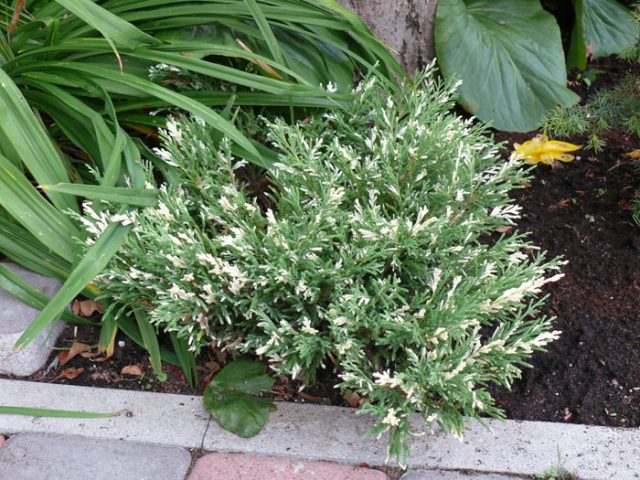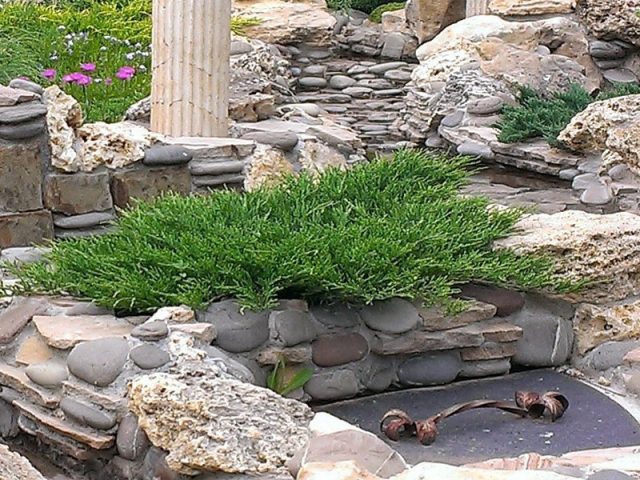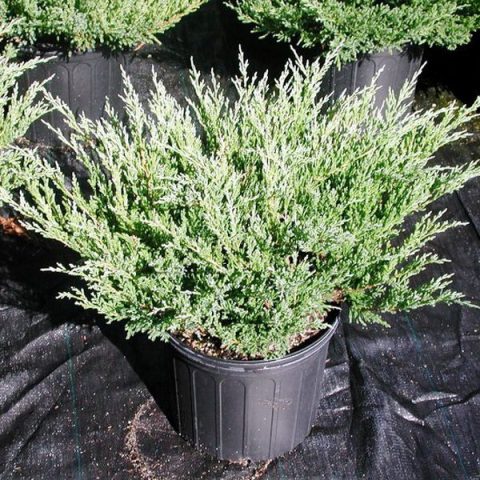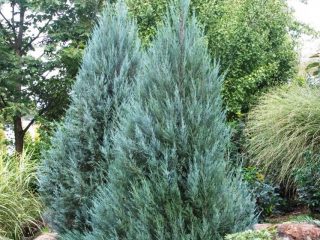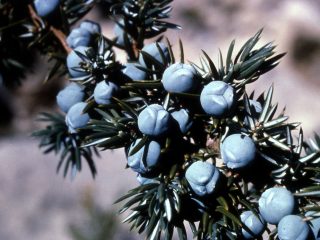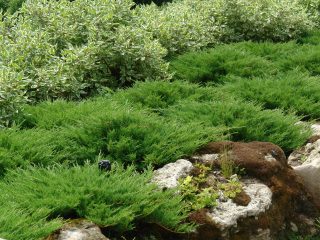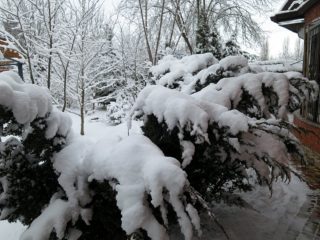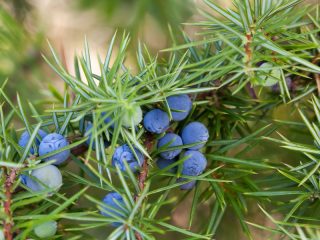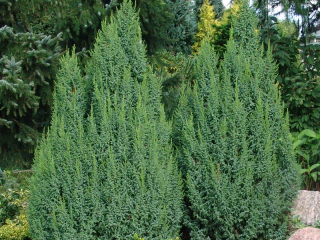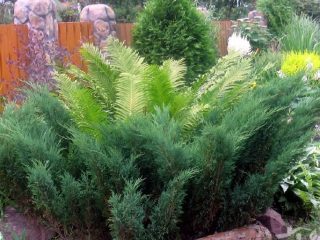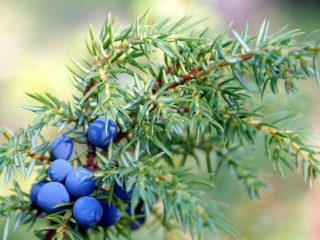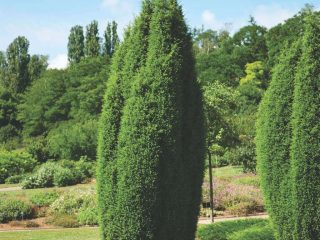Content
- 1 Description of juniper horizontal Andorra Compacta
- 2 Winter hardiness zone Andorra Compact
- 3 Juniper Andorra Compacta in landscape design
- 4 Planting and caring for juniper Andorra Compacta
- 5 Reproduction
- 6 Diseases and pests of horizontal juniper AndorraCompact
- 7 Reviews of juniper Andorra Compacta
- 8 Conclusion
Juniper Andorra Compacta is a compact cushion-shaped shrub. The plant has green needles all season, and purple in winter. This property attracts landscape designers. Due to its small growth, the evergreen crop looks impressive in the garden plot. An interesting tandem of creeping juniper and flowering plants.
The shrub is valuable not only for its decorative qualities, but also for its phytoncidal properties. The substances they emit destroy bacteria and make the air cleaner.
Description of juniper horizontal Andorra Compacta
Juniper Andorra Compacta is an evergreen, dwarf, flat-round plant. The branches are densely spaced, rising upward from the center at an acute angle and then growing horizontally. At an early age, the shape of the juniper resembles a nest-like crown.
The shrub grows 40 cm in height and 2 m in width.At the same time, the growth every year is: 3 cm in height, 10-15 cm in width. The color of the shoots is brown-green. The bark is brown, smooth in young plants, but prone to cracking in adults.
The root system is superficial, underdeveloped, but grows widely. The wood is resistant to rotting, so the crop is often planted near water bodies.
The needles are 0.5 cm long. They are mainly located on the shoots in whorls; the scaly or needle-shaped type is less common. The needles are soft and pleasant to the touch. Narrow, short needles are tightly pressed to the shoots. In summer it is gray-green, and in winter it takes on a purple hue.
Juniper Andorra Compacta produces spherical, fleshy, barely noticeable cones. At first the fruits are green, but over time they acquire a bluish-blue hue.
Another species similar to the Andorra Compacta shrub is the Andorra Variegata juniper. General signs:
- shoots grow close to the ground, spreading straight along it;
- the crown is spread wide;
- good frost resistance;
- the possibility of full growth without human intervention;
- use in landscape compositions.
Differences between Juniper horizontal Andorra Variegata:
- larger in size: height 0.5 m, width 3 m;
- asymmetrical bush shape;
- annual growth: height 15 cm, width – 20-30 cm;
- the structure of the needles is cup-shaped;
- the ends of the shoots are yellow-cream in color.
Winter hardiness zone Andorra Compact
Juniper Andorra Compacta easily tolerates sudden changes in temperature and air humidity. Belongs to winter hardiness zone 4. These are the territories of Moscow, Moscow region, Volgograd, Uralsk, Kazan. Withstands temperature range - 29-34 °C.
Juniper Andorra Compacta in landscape design
Evergreen shrubs are used both as a separately growing crop and in a group of plants. Suitable for landscaping garden plots, city parks, alleys. The horizontal juniper Andorra Compacta looks beautiful in the photo in landscape designs. Combines with low-growing varieties of shrubs - heather, Erica, roses and ground cover forms of pine. In Japanese gardens, shrubs are planted on the edge of retaining walls. When planted densely, juniper is used to strengthen slopes.
Planting and caring for juniper Andorra Compacta
The plant is undemanding. According to the described characteristics and photos, Andorra Compacta juniper easily grows in urban environments. Capable of growing independently without human intervention. However, it has a small annual growth of 5-7 cm. Under properly selected conditions, the life cycle of juniper is 200 years.
Preparation of seedlings and planting area
First of all, Andorra Compacta juniper seedlings must be well developed. Young growth, one or two-year-old plants with a branched root system, are suitable. The seedling should not show signs of rot or other diseases.
The day before the intended planting, the roots are cut by 3-5 cm and dipped into a solution with a stimulator. In addition, broken shoots are removed, side branches and the top are shortened by ½ the length of the growth.
The description of Andorra Compact horizontal juniper notes a preference for open sunny areas, but can tolerate partial shade. A moderate lack of lighting does not reduce the decorative properties of the shrub. A complete lack of sunlight leads to yellowing of the needles.
Grows well in sandy soils with a neutral or slightly acidic pH. Clayey, heavy soils are not suitable for planting horizontal juniper. For better plant survival, you can replace the existing soil with a new nutrient mixture. Main components: turf soil, peat, sand. Proportions 1:1. Or buy a ready-made substrate for conifers, mixing it with soil in equal parts.
A week before planting, you should prepare a planting container with dimensions of 0.8x1 m and a depth of 0.7 m. The dimensions of the pit should be 2-3 times larger than the earthen clod.
Landing rules
When choosing the future location of the horizontal juniper Andorra Compacta, you should take into account that an adult plant does not tolerate transplants well. Therefore, a suitable site must be selected immediately.
The period for spring planting of seedlings is the last days of April or the beginning of May. Autumn – October. When planting juniper at other times, slow growth and poor survival of the shrub are observed.
- A drainage layer of broken bricks and pebbles is placed at the bottom of the prepared pit. Provide a thickness of 20 cm.
- Nutrient components are added on top: humus or compost, charcoal, 20 g of complex mineral fertilizers.
- A sapling of horizontal juniper Andorra Compacta is placed in the middle of the recess and sprinkled with earth.
- The root collar should be at ground level.
- The soil is not compacted, but moistened generously with warm water.
- Every day after planting, the seedling is watered, and this is done for a week.
Watering and fertilizing
The young plant should be watered regularly for the first year.The root system cannot yet fully absorb water and nutrients from the ground. For the first 2-3 months, the creeping juniper Andorra Compacta is moistened every 2 days. Afterwards, during dry periods, water the bush once a week.
Fertilizers are applied in the spring. They mainly use nitroammophoska - 20 g per square meter. m or other minerals according to the manufacturer's instructions. In September, the bush is fed with potassium-phosphorus fertilizers.
Mulching and loosening
Horizontal juniper Andorra Compact suffers from dry air. To make moisture evaporate more slowly, the soil is mulched with sawdust or pine chips. The required layer is 5-10 cm.
Young bushes need regular loosening. After water is absorbed, the circle around the trunk is loosened shallowly. Thus, they saturate the soil with oxygen without damaging the root system.
Trimming and shaping
Horizontal juniper Andorra Compact is pruned in early spring before the onset of sap flow. Remove dry, damaged shoots. Frozen tips on the bush are also removed. At the end of the procedure, the plant is fed with nutrients and also treated with a fungicide solution. This further stimulates uniform growth of branches and protection against infections.
Preparing for winter
Only young shrubs are covered for the winter. To do this, use spruce branches, agrofibre or burlap. In adult junipers, the trunk circle is mulched with peat. Layer 10-20 cm. The plant also does not tolerate heavy snow. Fallen precipitation must be removed from the bush.
More detailed planting rules and conditions for caring for juniper Andorra Compacta are shown in the video:
Reproduction
The process of breeding juniper Andorra Compacta comes down to the seed method or cuttings. Experienced gardeners prefer propagation by semi-woody cuttings. When planting seeds, most often the characteristic features of the variety will be lost.
At the end of April, a cutting 10-15 cm long is cut off from a shrub at the age of 8-10 years. The needles are cleared to 5 cm, but the bark does not need to be touched. To make roots appear faster, a juniper branch is placed in a stimulating solution for half an hour. Then the cuttings are planted in containers with soil mixture.
The Andorra Compacta juniper cuttings are pressed tightly to the substrate. Cover the top with a film, creating a greenhouse effect. Moisten periodically as the soil in the pot dries out. After a month and a half, roots appear. At the end of June it can be planted in a permanent place of growth.
Diseases and pests of horizontal juniper AndorraCompact
Within a radius of 3 m, pine needle phytoncides destroy bacteria and harmful infections. Therefore, the plant rarely gets sick. However, spider mites and scale insects can still cause harm to Andorra Compacta juniper. You can fight them with insecticides: “Aktara”, “Match”, “Aktellik”.
A common disease among evergreen plants is root rot, which occurs due to excess moisture. For preventive purposes, juniper is sprayed once a month with systemic fungicides: “Skor”, “Maxim”, “Quadrix”.
If visual changes appear on the bush, then you need to get rid of the damaged area. This will prevent the infection from spreading and will protect nearby growing plants.
Chemicals are dangerous to human health, so do not neglect personal protective equipment when processing Andorra Compacta horizontal juniper.
Reviews of juniper Andorra Compacta
Conclusion
Juniper Andorra Compacta is an ornamental bush that pleases with its unfading appearance. Its compact size does not prevent it from being adjacent to other plants, creating an attractive composition. It requires virtually no maintenance, only in the first stages it is worth taking care of the coniferous crop so that it takes root and overwinters well.

